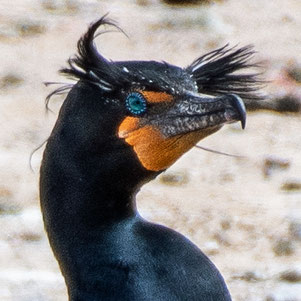New Mexico Birds: Suliformes
Hover over the photo series to control the images.
Phalacrocoracidae: Double-Crested Cormorant (Nannopterum auritum)

Double-crested cormorants winter in New Mexico along the Rio Grande and Pecos River, and each of those rivers includes a pocket of year-round residents. In Albuquerque, however, sightings are uncommon. When seen there, the key attribute for ID is the bright yellow lores (the spaces between the upper bills and the eyes). Also look for a large amount of yellow at the back of the jaw, and for a bird that's a little larger than the adjacent neotropic cormorants. If there's a white fringe to the back of the jaw, that's a neotropic (but not all neotropics display that attribute).
In the image to the left, the crest mentioned in the bird's name is no more than a few wisps near the top of the head.

In this image, taken a little later in the breeding season, the two crests are far more obvious. It helps that a breeze was ruffling the cormorant's crests.
Phalacrocoracidae: Neotropic Cormorant (Nannopterum brasilianum)
This species was formerly known as Phalacrocorax brasilianus. Neotropic cormorants have established a seasonal home base on an island in Tingley Beach. They appear in a group at the start of the year; in the spring, chicks' heads pop up from the twiggy nests. During the day, the colony scatters up and down the Rio Grande to hunt fish. As the year wears on, most of them head for other places.
When cormorants swim on the surface, their bodies are mostly underwater. I'm distinguishing these birds from double-crested cormorants (P. auritus) based on attributes such as the lack of highly obvious yellow lores (the spaces between the beaks and eyes), the limited yellow at the base of the beak, the thin whitish fringe to the beak (often not obvious), and how brown the juveniles' breasts are.



































